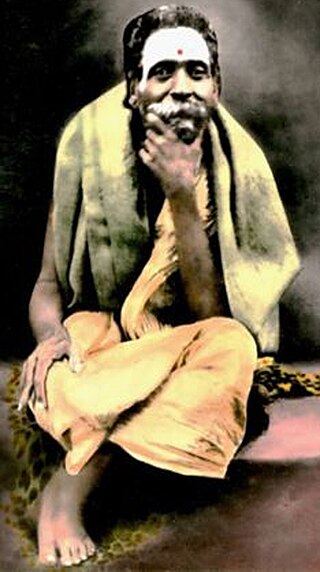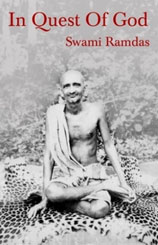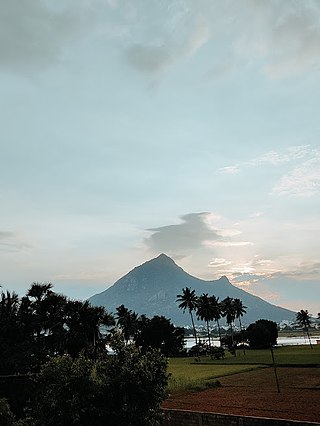
Ramana Maharshi was an Indian Hindu sage and jivanmukta. He was born Venkataraman Iyer, but is mostly known by the name Bhagavan Sri Ramana Maharshi.

Sri Seshadri Swamigal, also known as the "Saint with a Golden Hand", was a male Indian saint born in Kanchipuram, Tamil Nadu, who predominantly lived in Tiruvannaamalai where he attained Samadhi.

Swami Ramdas was an Indian saint, philosopher, philanthropist and pilgrim. Swami Ramdas became a wandering ascetic in his late 30s and after attaining moksha while still alive established Anandashram in Kanhangad, Kerala. He is the author of several books, the most famous of which is the spiritual autobiography In Quest of God (1925).

Self-enquiry, also spelled self-inquiry, is the constant attention to the inner awareness of "I" or "I am" recommended by Ramana Maharshi as the most efficient and direct way of discovering the unreality of the "I"-thought.

Arunachala is a hill in Tiruvannamalai, Tamil Nadu, and one of the five main Shaiva holy places in South India. The Arunachalesvara Temple to Shiva is located at the base of the hill. The hill is also known by the names Annamalai, Arunagiri, Arunachalam, Arunai, Sonagiri, and Sonachalam.
A. R. Natarajan was a disciple of Sri Ramana Maharshi who published numerous books on his guru. He was the president and founder of the Ramana Maharshi Centre for Learning, Bangalore) the Bhagavan Sri Ramana Maharshi Research Centre and the vice-president of the Ramana Kendra, New Delhi."Bangaloreans would not have had the opportunity of learning about Bhagwan Shri Ramana, but for the efforts put by Shri.A.R.Natarajan in building RMCL at Mekhri Circle, Bangalore" said Mr.Shadakshari, a Great Devotee of Shri.Ramana Maharshi.Shri.A.R.Natarajan was the editor of the journal The Mountain Path, the official Publication of Sri Ramanashramam, Tiruvannamalai.. He authored several books on Sri Ramana Maharshi like "DIVINITY, HERE & NOW".
Yogi Ramsuratkumar was an Indian saint and mystic. He was also referred to as "Visiri samiyar" and spent most of his post-enlightenment period in Tiruvannamalai, a small town in Tamil Nadu which is famous for attracting spiritual seekers worldwide and has had a continuous lineage of enlightened souls. He acknowledges the contribution of three of the most well known saints of his time in his evolution to enlightenment. These individuals were Sri Aurobindo, the founder of Integral yoga, Ramana Maharshi, one of the "spiritual supermen" of his time, and Swami Ramdas, Yogi's eventual guru.

Nome is a spiritual teacher at Society of Abidance in Truth, known by the acronym SAT, which established and maintains a temple for nondual Self-knowledge in California. He expounds the teachings of Sri Ramana Maharshi and Advaita Vedanta. He, along with Dr. H. Ramamoorthy, translated into English the essential and classic work of Advaita Vedanta, "Ribhu Gita", which was highly recommended by Sri Ramana Maharshi. The English translation has been published by Society of Abidance in Truth and has since then been re-published by Sri Ramanasramam and translated into Hindi, Italian, Korean and German.

The Society of Abidance in Truth (SAT) is a spiritual nonprofit organization consecrated to the teachings of Advaita Vedanta, especially as revealed by Sri Ramana Maharshi.
Mouni Sadhu was the pen name of Mieczyslaw Demetriusz Sudowski, a Polish-born author of spiritual, mystical, and esoteric subjects. He lived in Poland until World War II and eventually settled in Australia where he became a naturalized citizen. He wrote about Western and Eastern spirituality firstly, and also occultism both Western and Eastern, including Hermeticism, and the Yoga tradition of India. His greatest personal influence was Ramana Maharshi. The name "Mouni Sadhu" means "silent monk" in Sanskrit.
Ethel Merston was one of G. I. Gurdjieff’s first students at his Institute for the Harmonious Development of Man, at the Prieuré in Fontainebleau-en-Avon, France. Gurdjieff had recently come to the West to introduce an esoteric teaching called the Fourth Way. She wrote a memoir based on her diaries giving a keen insight into many of the seminal teachers of her times.

Anandashram is a spiritual retreat located in Kanhangad, a city and a municipality in Kasaragod district in the Indian state of Kerala. Anandashram was founded by Swami Ramdas and Mother Krishnabai, also called Papa Ramdas and Pujya Mataji, in 1931.

Swami Nigamananda Paramahansa was an Indian yogi, guru and mystic well known in Eastern India. He is associated with the Shakta tradition and viewed as a perfect spiritual master of vedanta, tantra, yoga and prema or bhakti. His followers idealized him as their worshipped and beloved thakura.
Arthur Osborne was an English writer on spirituality and mysticism, and an influential disciple and biographer of Ramana Maharshi.

Robert Adams was an American Advaita teacher. In later life Adams held satsang with a small group of devotees in California, US. He mainly advocated the path of jñāna yoga with an emphasis on the practice of self-enquiry. Adams' teachings were not well known in his lifetime, but have since been widely circulated amongst those investigating the philosophy of Advaita and the Western devotees of Bhagavan Sri Ramana Maharshi. A book of his teachings, Silence of the Heart: Dialogues with Robert Adams, was published in 1999.
Ayyala Somayajulu Ganapathi Sastry, also known as Ganapati Muni (1878–1936), was a disciple of Ramana Maharshi. He was also variously known as "Kavyakantha", and "Nayana" by his disciples.

David Godman has written on the life, teachings and disciples of Ramana Maharshi, an Indian sage who lived and taught for more than fifty years at Arunachala, a sacred mountain in Tamil Nadu, India. In the last 30 years Godman has written or edited 16 books on topics related to Sri Ramana, his teachings and his followers.

Jiří Vacek was a Czech mystic, writer and translator of spiritual literature.

Manavasi Ramaswami Iyer was a devotee of Ramana Maharshi. He composed the well-known song Saranagati in his devotion to Ramana Maharshi, which is still sung by devotees of Ramana Maharshi today.
Girivalam is a Hindu religious practice held in Tiruvannamalai, India, that involves devotees embarking on a sacred pilgrimage around the foothills of Arunachala, also known as Arunachala Hill, mainly on full moon nights.




















